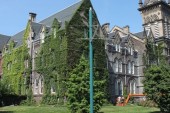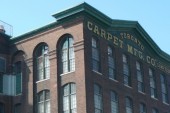
 (Arianna Perricone)
(Arianna Perricone)
I was in Santiago two years ago, walking around the neighbourhood called El Golf looking for a caf with a patio, when I noticed a plaque on one of the apartment buildings. I thought it was going to be one of those things that told you some revolutionary or poet lived here. But it was the name of the architect who designed the building, along with the year it was built. I’d never seen anything like it before, but I loved the idea, and kept an eye out for more. By the end of the week, I’d probably seen half a dozen.
I’m a big fan of plaques. It’s one of the things I like most about London, actually, odd as it may sound. Those blue ceramic plaques on the fronts of houses and other buildings telling you Oscar Wilde lived here, Charles Dickens wrote here, George Eliot died here. Of course I know they lived in London, and know that, from time to time, I’ll be walking on the same street Virginia Woolf once strode in purposeful contemplation of the idea of having been born 50 years later so she could have stopped beating around the bush and gotten down to some proper lady-snogging. But to see it, written out, lets you meditate a little, or me, anyway. Whenever I see one that means anything to me, I’ll stop, picture Samuel Johnson shuffling down that alleyway over there and climbing the two or three steps to that front door, stopping at the top to catch his breath before getting his key out.
It starts like, that, anyway, and then it spreads out. Just like when we first start to learn about our intellectual, political, artistic or technological history, we tend to think of it as stories of individuals, until we realize that they’re more markers than lone movers, Woolf was able to do what she did because of Leonard, Vita and the rest, as well as the people she read in the papers and journals, and the man she talked to at the flower market. So after a few seconds of musing about whether Johnson kept that house key on a fob in his waistcoat, I start picturing everyone else bustling about this little courtyard in the latter bits of the 18th century. It humanizes history, for a start, but it also puts me in my place, reminds me where I stand, and of all those other metaphors that emphasize the importance of being aware of your surroundings and your relationship to them.
We’ve got a few of these sorts of things in Toronto—Cabbagetown has been pretty good at telling us where its poets and scientists spent their time. And we’ve started putting up plaques commemorating spots that have been commemorated in books. But because we’ve got a mania for misplaced understandings of privacy, we often screw them up our opportunities, like the plaque on Avenue around Dupont that tells you that Robertson Davies lived nearby. Nearby: How inspiring is that. And there’s still nothing in front of 3 Wychwood Park Avenue to indicate it’s where Marshall McLuhan spent his most productive years, no doubt because the current occupants don’t want to draw attention and attract the wrong element.
But in the middle of that horrible July council session that vituperatively scrapped the little white lines on Jarvis Street that told cyclists the city realizes we’re here, and did any number of things to remind us that we really should be making fun of Ford’s tiny interior life rather than his big belly, something good happened. Thanks to Peter Milczyn, a staunch Ford supporter and longtime architecture aficionado who was rewarded for his support by being given the chairmanship of the planning and development committee, it is now law in this city that every building over 1,000 square metres (or about 10,700 square feet) must have a plaque prominently displayed letting us know who the architect is.
“There used to be a tradition of laying cornerstones for significant buildings, and often naming the architect. This new initiative, once it starts being implemented, will leave behind a legacy of ‘signed’ buildings that will also engage the public into a more vibrant discussion about architecture,” says Milczyn sounding like he may not have gone to the same school as Ford.
I didn’t recognize any of the names on those plaques in Chile, or the ones I saw later in Tel Aviv. There may have been some famous names, but I didn’t see them. Which is one way these sorts of plaques differ from those blue ones in London. Of the thousands of books that get published every year, a few might have an effect on some of us. And as the years go by, a much smaller number grow in importance, and become an influence on many of us. But what I love about this new by-law is that it doesn’t leave it up to developers or anyone else to decide which buildings are significant enough to warrant cornerstones. It acknowledges that every building that goes up in a city has an immediate and lasting effect on everyone that walks by it, works in it, shops in it, sits in front of it, builds next to it or sits in front of it. These plaques aren’t about starchitects, they’re about architecture, the fact that humans are behind it, and the role it all plays in our lives.
And those humans seem to be big fans of the idea.
“I think it is an excellent way to celebrate the contribution architects make to the shape and character of our city,” says Roland Rom Colthoff of RAW Design, the firm behind the BMW dealership that looks like a big vending machine from the DVP, and new Mini dealership on Eastern Avenue. “It can inform people about buildings they may admire and enrich their knowledge of the city. Similarly it might give some architects pause if they realize their name will appear for posterity on a design that perhaps might benefit from further study.”
“It’s gratifying to see council acknowledge the people and firms that shape the fabric of the city,” says Mary McIntrye from Architects Alliance, the firm behind many of the past decades condo towers, including Sackville-Dundas and Spire. “Anything that makes people more conscious of the fact that buildings don’t just ‘happen’ is a good thing.”
And at least one, Les Klein of Quadrangle (the folks behind the Toy Factory, and the interior of Corus Quay), figures it’s a corrective to those big signs that stay in front of buildings for the months and years it takes to build them letting everyone know it’s a Minto, a Tridel, or a Peter Freed.
“When the project construction sign lists the architect on the fourth or fifth line under the developer, project manager, construction manager, lawyer and mortgage company, something is amiss,” Klein says by email. “And when a real estate agent or a plumber can point to a building and say, ‘I did that project,’ without mentioning that perhaps an architect might also have had a hand in its creation, something is very wrong. The OAA has long had a clause in the standard agreement between the architect and the client allowing the architect to ‘sign’ their building (at their cost, of course), but few of us have ever taken advantage of it.”
Almost all the architects I polled on the subject agreed that this new law might have a substantial side effect. “If architects know that their names will be on their buildings, perhaps they will strive just a bit harder to make it a better building,” Klein says.
The side effect’s entirely intentional. “If architects know that there name will go on the building it is an added incentive to do better,” Milzyn says.
We can be both beneficiaries and victims of architecture, often for decades, sometimes centuries. No matter how universal the distress over a building like Page and Steele/IBI Group’s Bohemian Embassy or pretty much anything designed by Diamond and Schmitt (like the Four Seasons ballet and opera house, the exterior of Corus Quay and most of the other blanks where buildings should be across the city), they’ll be with us for a long, long time, making our lives just a little bit worse. And just as it’s nice to be able to know whom to thank for 1 St. Thomas or the Bata Shoe Museum, it’s also good to be able to focus your rage, and possibly even bring ammunition to your next public meeting when the same architect’s up for a job in your neighbourhood.














